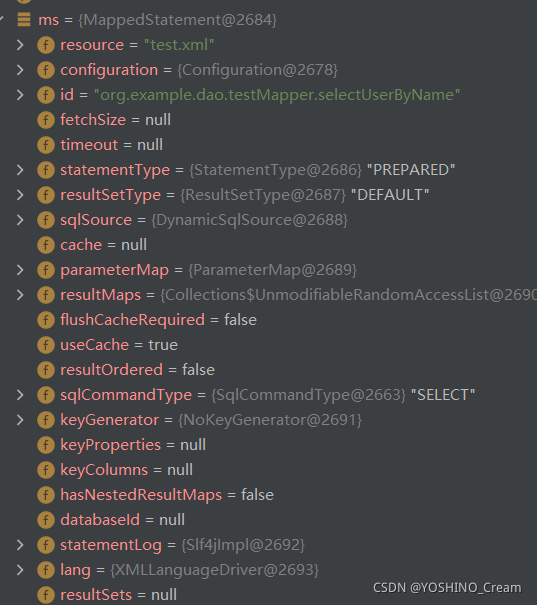准备一个测试方法
SqlSession sqlSession = sqlSessionFactory.openSession();
testMapper mapper = sqlSession.getMapper(testMapper.class);
List<User> admin = mapper.selectUserByName("test1");进入selectUserByName()方法;
进入到了MapperProxy.class中
public Object invoke(Object proxy, Method method, Object[] args) throws Throwable {
try {
return Object.class.equals(method.getDeclaringClass()) ? method.invoke(this, args) : this.cachedInvoker(method).invoke(proxy, method, args, this.sqlSession);
} catch (Throwable var5) {
throw ExceptionUtil.unwrapThrowable(var5);
}
}执行invoke方法,先判断传入的代理对象中是否有与Object类相同的方法(比如clone(),toString()等),若有则直接执行
若没有则调用cachedInvoker()方法
private MapperProxy.MapperMethodInvoker cachedInvoker(Method method) throws Throwable {
try {
return (MapperProxy.MapperMethodInvoker)MapUtil.computeIfAbsent(this.methodCache, method, (m) -> {
if (m.isDefault()) {
try {
return privateLookupInMethod == null ? new MapperProxy.DefaultMethodInvoker(this.getMethodHandleJava8(method)) : new MapperProxy.DefaultMethodInvoker(this.getMethodHandleJava9(method));
} catch (InstantiationException | InvocationTargetException | NoSuchMethodException | IllegalAccessException var4) {
throw new RuntimeException(var4);
}
} else {
return new MapperProxy.PlainMethodInvoker(new MapperMethod(this.mapperInterface, method, this.sqlSession.getConfiguration()));
}
});
} catch (RuntimeException var4) {
Throwable cause = var4.getCause();
throw (Throwable)(cause == null ? var4 : cause);
}
}可以看到cachedInvoker返回了一个MapperMethodInvoker,顾名思义,是mapper方法的执行器,即为我们自己写的方法的执行器。来到这个方法后,依旧先进行一个判断,若为JVM规定的默认方法,,则调用另一个执行器。显然咱们这里不是,直接return new MapperProxy.PlainMethodInvoker(new MapperMethod(this.mapperInterface, method, this.sqlSession.getConfiguration()));
在将传入的参数封装成了MapperMethod对象后调用了一个PlainMethodInvoker()方法
这个PlainMethodInvoker又是什么呢
private static class PlainMethodInvoker implements MapperProxy.MapperMethodInvoker {
private final MapperMethod mapperMethod;
public PlainMethodInvoker(MapperMethod mapperMethod) {
this.mapperMethod = mapperMethod;
}
public Object invoke(Object proxy, Method method, Object[] args, SqlSession sqlSession) throws Throwable {
return this.mapperMethod.execute(sqlSession, args);
}
}
interface MapperMethodInvoker {
Object invoke(Object var1, Method var2, Object[] var3, SqlSession var4) throws Throwable;
}原来是一个实现了MapperMethodInvoker的一个内部静态类,调用了构造方法创建了一个PlainMethodInvoker 对象。现在再来看这行代码
return Object.class.equals(method.getDeclaringClass()) ? method.invoke(this, args) : this.cachedInvoker(method).invoke(proxy, method, args, this.sqlSession);
本质就是经过一系列的判断,最后生成一个PlainMethodInvoker并执行他的invoke()方法
而PlainMethodInvoker的invoke方法最终是执行了mapperMethod的execute()方法
现在进入该方法体探究一下:
public MapperMethod(Class<?> mapperInterface, Method method, Configuration config) {
this.command = new MapperMethod.SqlCommand(config, mapperInterface, method);
this.method = new MapperMethod.MethodSignature(config, mapperInterface, method);
}
public Object execute(SqlSession sqlSession, Object[] args) {
Object result;
Object param;
switch(this.command.getType()) {
case INSERT:
param = this.method.convertArgsToSqlCommandParam(args);
result = this.rowCountResult(sqlSession.insert(this.command.getName(), param));
break;
case UPDATE:
param = this.method.convertArgsToSqlCommandParam(args);
result = this.rowCountResult(sqlSession.update(this.command.getName(), param));
break;
case DELETE:
param = this.method.convertArgsToSqlCommandParam(args);
result = this.rowCountResult(sqlSession.delete(this.command.getName(), param));
break;
case SELECT:
if (this.method.returnsVoid() && this.method.hasResultHandler()) {
this.executeWithResultHandler(sqlSession, args);
result = null;
} else if (this.method.returnsMany()) {
result = this.executeForMany(sqlSession, args);
} else if (this.method.returnsMap()) {
result = this.executeForMap(sqlSession, args);
} else if (this.method.returnsCursor()) {
result = this.executeForCursor(sqlSession, args);
} else {
param = this.method.convertArgsToSqlCommandParam(args);
result = sqlSession.selectOne(this.command.getName(), param);
if (this.method.returnsOptional() && (result == null || !this.method.getReturnType().equals(result.getClass()))) {
result = Optional.ofNullable(result);
}
}
break;
case FLUSH:
result = sqlSession.flushStatements();
break;
default:
throw new BindingException("Unknown execution method for: " + this.command.getName());
}
if (result == null && this.method.getReturnType().isPrimitive() && !this.method.returnsVoid()) {
throw new BindingException("Mapper method '" + this.command.getName() + " attempted to return null from a method with a primitive return type (" + this.method.getReturnType() + ").");
} else {
return result;
}
}显示判断增删改查标签,这里我们是select所以进入select对应语句段,再判断返回值类型,我们这里是List类型,所以进入returnMany语句块,执行executeForMany()方法来获得结果。
private <E> Object executeForMany(SqlSession sqlSession, Object[] args) {
Object param = this.method.convertArgsToSqlCommandParam(args);
List result;
if (this.method.hasRowBounds()) {
RowBounds rowBounds = this.method.extractRowBounds(args);
result = sqlSession.selectList(this.command.getName(), param, rowBounds);
} else {
result = sqlSession.selectList(this.command.getName(), param);
}在executeForMany方法中首先是对参数进行封装,这里我们先不讨论,接建立一个存放结果的list,先判断该方法是否与分页相关,若相关,则封装一个RowBounds对象再进行查询,若不相关,则直接进行查询,调用的是sqlSession的selectList()方法。
进入selectList()
public <E> List<E> selectList(String statement, Object parameter) {
return this.selectList(statement, parameter, RowBounds.DEFAULT);
}
public <E> List<E> selectList(String statement, Object parameter, RowBounds rowBounds) {
return this.selectList(statement, parameter, rowBounds, Executor.NO_RESULT_HANDLER);
}
private <E> List<E> selectList(String statement, Object parameter, RowBounds rowBounds, ResultHandler handler) {
List var6;
try {
MappedStatement ms = this.configuration.getMappedStatement(statement);
var6 = this.executor.query(ms, this.wrapCollection(parameter), rowBounds, handler);
} catch (Exception var10) {
throw ExceptionFactory.wrapException("Error querying database. Cause: " + var10, var10);
} finally {
ErrorContext.instance().reset();
}
return var6;
}经过层层调用,最终来到了含4个参数的selectList()方法,来看一看参数
1.statement:与查询相关
2.parameter: 顾名思义,应该是我们传入的参数
3.Rowbound: 与分页有关的类
4.ReslutHandler: 结果处理器
在方法中,先是获取了配置中的MappedStatement,它包含了所有的与查询相关的信息

然后执行了executor的query方法,executor本实是一个接口,这里来到的是它的实现类
cacheExecutor中
public <E> List<E> query(MappedStatement ms, Object parameterObject, RowBounds rowBounds, ResultHandler resultHandler, CacheKey key, BoundSql boundSql) throws SQLException {
Cache cache = ms.getCache();
if (cache != null) {
this.flushCacheIfRequired(ms);
if (ms.isUseCache() && resultHandler == null) {
this.ensureNoOutParams(ms, boundSql);
List<E> list = (List)this.tcm.getObject(cache, key);
if (list == null) {
list = this.delegate.query(ms, parameterObject, rowBounds, resultHandler, key, boundSql);
this.tcm.putObject(cache, key, list);
}
return list;
}
}
return this.delegate.query(ms, parameterObject, rowBounds, resultHandler, key, boundSql);
}从类名我们不难猜测,这是一个从缓存中查找结果的类,首先从mapperstatement中获取一个缓存对象,若不为空,则继续进行,再判断是否开启了二级缓存且尚未获得结果,若都符合,则直接从二级缓存中获取,若获取不到,则从数据库中查询,并将查询的结果放入缓存中。
此时是第一次查询,必须从数据库中获取数据。
来到下一个query方法,此时进程从cacheExecutor中来到BaseExecutor中
public <E> List<E> query(MappedStatement ms, Object parameter, RowBounds rowBounds, ResultHandler resultHandler, CacheKey key, BoundSql boundSql) throws SQLException {
ErrorContext.instance().resource(ms.getResource()).activity("executing a query").object(ms.getId());
if (this.closed) {
throw new ExecutorException("Executor was closed.");
} else {
if (this.queryStack == 0 && ms.isFlushCacheRequired()) {
this.clearLocalCache();
}
List list;
try {
++this.queryStack;
list = resultHandler == null ? (List)this.localCache.getObject(key) : null;
if (list != null) {
this.handleLocallyCachedOutputParameters(ms, key, parameter, boundSql);
} else {
list = this.queryFromDatabase(ms, parameter, rowBounds, resultHandler, key, boundSql);
}
} finally {
--this.queryStack;
}
if (this.queryStack == 0) {
Iterator var8 = this.deferredLoads.iterator();
while(var8.hasNext()) {
BaseExecutor.DeferredLoad deferredLoad = (BaseExecutor.DeferredLoad)var8.next();
deferredLoad.load();
}
this.deferredLoads.clear();
if (this.configuration.getLocalCacheScope() == LocalCacheScope.STATEMENT) {
this.clearLocalCache();
}
}
return list;
}
}首先从一级缓存中获取,若没获取到,则执行.queryFromDatabase()方法,从方法名可以看出,这是从数据库中查询的方法。
private <E> List<E> queryFromDatabase(MappedStatement ms, Object parameter, RowBounds rowBounds, ResultHandler resultHandler, CacheKey key, BoundSql boundSql) throws SQLException {
this.localCache.putObject(key, ExecutionPlaceholder.EXECUTION_PLACEHOLDER);
List list;
try {
list = this.doQuery(ms, parameter, rowBounds, resultHandler, boundSql);
} finally {
this.localCache.removeObject(key);
}
this.localCache.putObject(key, list);
if (ms.getStatementType() == StatementType.CALLABLE) {
this.localOutputParameterCache.putObject(key, parameter);
}
return list;
}首先将对应的key放入一级缓存,并放入一个常量占位。
再创建一个list来存贮结果。
之后执行查询,最后将查询结果放入缓存中一份。
来到simpleExecutor的doQuery方法
public <E> List<E> doQuery(MappedStatement ms, Object parameter, RowBounds rowBounds, ResultHandler resultHandler, BoundSql boundSql) throws SQLException {
Statement stmt = null;
List var9;
try {
Configuration configuration = ms.getConfiguration();
StatementHandler handler = configuration.newStatementHandler(this.wrapper, ms, parameter, rowBounds, resultHandler, boundSql);
stmt = this.prepareStatement(handler, ms.getStatementLog());
var9 = handler.query(stmt, resultHandler);
} finally {
this.closeStatement(stmt);
}
return var9;
}方法中先创建了statement,再获取了配置对象,然后创建了StatementHandler对象,再将创建的statement对象进行预编译,最后用StatementHandler对象进行查询。
来到handler的query()方法
RoutingStatementHandler.class
public <E> List<E> query(Statement statement, ResultHandler resultHandler) throws SQLException {
return this.delegate.query(statement, resultHandler);
}调用了query方法后来到PreparedStatementHandler.class
public <E> List<E> query(Statement statement, ResultHandler resultHandler) throws SQLException {
PreparedStatement ps = (PreparedStatement)statement;
ps.execute();
return this.resultSetHandler.handleResultSets(ps);
}先把statement包装成PreparedStatement后,调用了熟悉的execute方法,
最后将PreparedStatement对象传进handleResultSets()中,进行结果的解析。
结果封装完成后再一层层的返回,这样就得到了查询的结果。





















 1792
1792











 被折叠的 条评论
为什么被折叠?
被折叠的 条评论
为什么被折叠?








